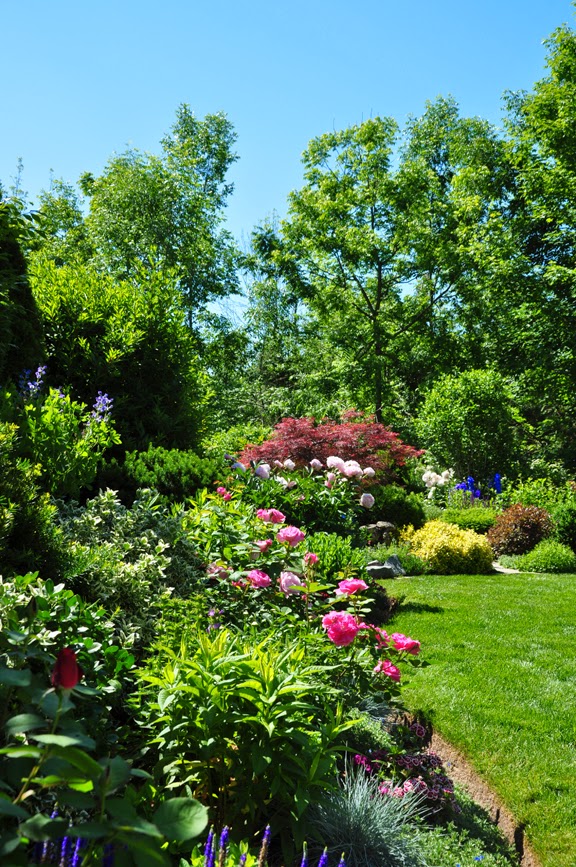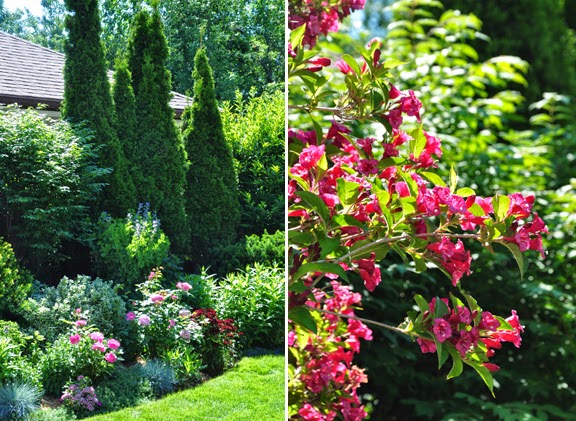I came away from my recent trip to Nova Scotia with a renewed fascination for some of
plant world's smallest members.
The rockgarden in Truro, Nova Scotia
Back home in Ontario, I have two miniature gardens that I created a few years ago using old concrete birdbaths.
I like the birdbaths because they bring these delicate looking plants up where you can best admire their texture and diminutive blooms.
Both birdbaths have homes in my back garden. Usually I remove the saucer-like top of each birdbath and put them in a protected spot to overwinter. Last fall was hectic, however. I managed to remove only one of the two birdbath tops, and only got as far as placing it on the ground. As luck would have it, a winter long covering of snow protected this saucer.
Unfortunately, the other birdbath top was left on its stand all winter and took a beating. Harsh winds and extremely cold temperatures ended up killing all its plants.
Thankfully the birdbath top on the ground sprang back to life this spring.
The moral of this story is: In areas as far north as zone 6b, all birdbath planters definitely
need some sort of winter protection!
Inspired by my trip home to Nova Scotia, I decided to create a third birdbath planter for the front garden.
Like most birdbaths, this terra cotta birdbath comes in two pieces. (purchased at Terra Nurseries in Milton, ON)
(Terra cotta will crack in winter, so this birdbath will need to be stored in a cool, dry place like a heated garage overwinter. So far (knock wood!), I have had not problems with my concrete birdbaths cracking in winter.)
To start your birdbath planter, fill the top saucer halfway with fine gravel. I used pea gravel, but if you can find a finer gravel, so much the better. (Note: I have never drilled a hole in the bottom of my birdbaths for drainage. The gravel alone seems to provide enough drainage.)
Find yourself an empty pot and mix together equal portions of fine gravel and a good quality top soil. Gauge the amount of topsoil/gravel mixture you need according to the size of your birdbath.
Now pour the gravel and topsoil mixture on top of your first layer of pea gravel. Ideally when you are finished pouring, the soil/gravel mixture should be just below the top lip of the birdbath.
Now you are ready to start planting.
This particular birdbath planter will be in full sun.
There is a wide array of plants you could choose from for sunny conditions. I could imagine a birdbath planted with something as simple as tiny white alyssum or trailing mini-petunias could be quite nice.
For my own birdbath planter, I chose perennials: Thrift 'Nifty Thrifty' (top left), Scotch Moss, Sagina Subulata 'Aurea' (top right), Elfin Thyme (bottom left), and Crane's Bill Geranium, Erodium 'Bishop's Form'. I also used (not show here): Pink's 'Brilliant', Dianthus deloides and Adriatic Bellflower, Campanula garganica 'Dickson's Gold', Wooly thyme and a tray of succulents.
If you have shade, fear not. There are still lots of plants you can choose from.
There are small scale ferns and Creeping Jenny (as seen here).
How about using Ajuga, 'Chocolate Chip' (top left), Dwarf Goatsbeard, Aruncus aethusifolius (top right), Lamium 'Red Nancy' (bottom left) or Creeping Speedwell, Veronica filiformis (bottom right)?
Miniature hostas are another group of plants you might want to consider for shade conditions. (Warning: these hosta are adorable, but very pricy! Maybe get a gardening friend to buy a second variety and trade pieces.)
Hosta 'Ruffled Mouse Ears' (top left), Hosta 'Cherish' (top right), Hosta 'Mini Skirt' (bottom left), and Hosta 'Cracker Crumbs' (bottom right). Who comes up with these names anyway? Hosta 'Cracker Crumbs'. How cute is that?
Adriatic Bellflower, Campanula garganica 'Dickson's Gold'
Begin planting along the outer circumference of the top saucer. Plants that will trail or spill over the lip of the birdbath are a nice choice.
As you dig down carefully, you will displace some of the soil and gravel to make room for the roots of the potted plants you are adding.
Spread the displaced soil evenly, slightly mounding it up in centre. In doing so, you are creating a bit of a rounded mushroom shape. (If you need to, you can always discard some excess soil mix back into the terra cotta pot where you created your soil/gavel mixture.)
Top dress any gaps between your plants with a sprinkling of more gravel. Add any decorations you want. I added a trio of little ceramic mushrooms purchased at the Dollarstore.
Water well until your plants are established and enjoy.
Here are two other birdbath planters that might inspire you. This birdbath is filled with an assortment of hostas and has Creeping Jenny spilling over the sides.
This birdbath is a shady spot is planted with ferns and Creeping Jenny.
What really makes it special however, is not the plants. It's the wonderful smooth, black pebbles.
Have a wonderful weekend!
Bookmark this blog post with this Pin.

















































